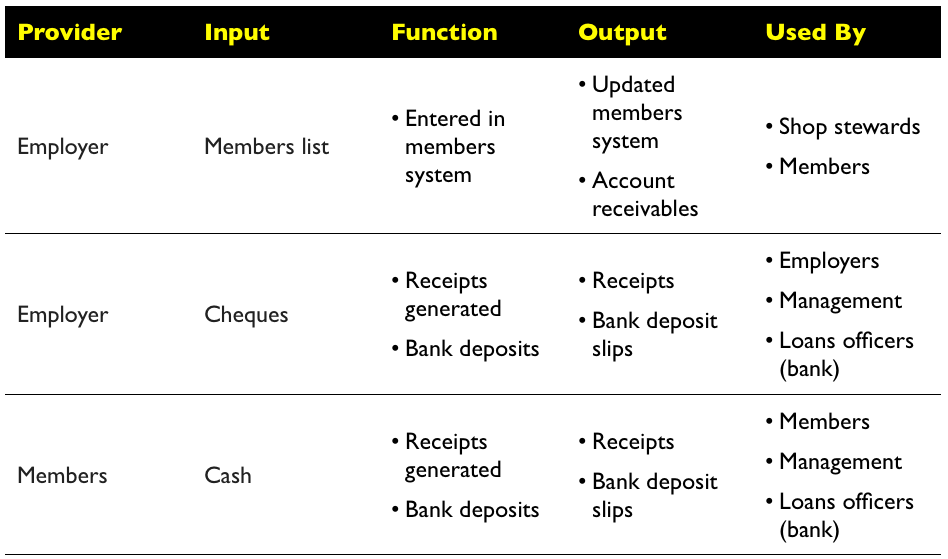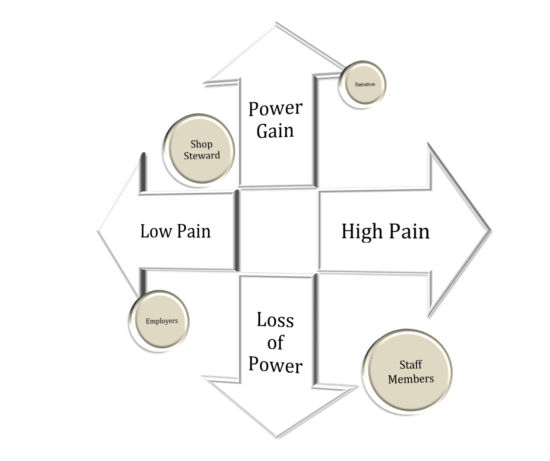Begin stakeholder analysis by identifying and examining how each interacts with the organization when they provide or receive services or benefits. External or internal people, systems, and other groups comprise stakeholders. They interact with the group through a specific process.
Identify process stakeholders and examine their contributions to the process (inputs) and benefits or what they receive from the process (outputs). Use the three-step approach below to identify process stakeholders.
One – Identify inputs
- What inputs does the process require, or what goes into the process? Consider using the FAST Creativity Exercise to help prevent missing items.
- Who provides each input from Activity 1 immediately above? Link the source(s) of each input.
- Where does the input go? Describe the activities and how each activity plays out.
Two – Identify outputs
- What outputs does the process create? List them as “things” or nouns such as a form, report, or event (e.g., deposit).
- Who uses or benefits from the output of the process—link to the client(s) of each output.
- What creates the output? Describe activities that depend on the outputs and how each makes them into something of value.
Three – Identify stakeholders
- Link each input/ output to one/ more stakeholders by one/ more activities within a process. Meanwhile, a stakeholder relationship shown in the table below clarifies the relationship between stakeholder, input, output, and activity within the process.
Stakeholders’ Relationships
Group Stakeholders
Therefore, stakeholders can be grouped together according to how they use or interact with the inputs and outputs. From the table above members and employers group together because “Payers” interact with the collection process in the same manner.
Acknowledge Stakeholder Interests
The motives and needs of the stakeholders determine their interest in the process and indicate how they can contribute/ derail the success of the project.
Define Stakeholder Strategy Plan
The stakeholder strategy plan provides a blueprint for the BPI (i.e., Business Process Improvement) team’s interaction with stakeholders. Focus on the stakeholder’s contribution shows how the team can use the stakeholder’s interests to support the project and make it successful.
The plan identifies
- What the project wants to achieve with each stakeholder
- Stakeholder issues and interests
- How stakeholders will be managed
- The frequency of communication
- The changing content of communication over the life of the project
The plan must be constantly updated to reflect changes in stakeholder opinions over the life of the project. The template below supports the development of the stakeholder strategy plan.
Stakeholder Strategy Plan Answers . . .
Stakeholder Name:_____________________________
- The objectives of the strategy plan . . .
- It is important for the project to have a stakeholder plan because . . .
- The purpose of the process is to . . . So that . . .
- Give a short description of the stakeholder group:
- The members of this stakeholder group are . . .
- Describe this group’s role in the process.
- Identify inputs the group provides:
- Identify outputs the group uses:
- Stakeholder thinks that the current process . . .
- Stakeholder thinks this because . . .
- Stakeholder’s interest in the current process . . .
- Stakeholder’s power in the current process…
- Stakeholder thinks that the BPI project . . .
- Stakeholder’s likely reaction:
- Stakeholder wants . . . from an improved process.
- It is essential for the stakeholders to support the project because:
- Without the stakeholders’ support . . .
- Stakeholders’ support . . .
- Stakeholders can contribute to the success of the project by . . .
- The stakeholder can hamper the project by . . .
- The BPI team wants the stakeholder to . . .
- Three things that are important to the stakeholder are:
- The team can guarantee . . .
- We need to tell the stakeholder . . .
- We need to tell them because . . .
- The best way to communicate with this group is to . . .
- This will cost (prepare a budget):
- We need to meet with this group because/ when:
- At what points in the project is it critical to meet with each stakeholder?
- How do we deal with confidentiality issues?
- Can each team member be privy to all information?
- Can each stakeholder be privy to all information?
- What is the strategy to ensure that confidential information stays that way?
Develop a Communications Action Plan
The communications action plan identifies exactly how and when a project team will communicate with each target audience (or stakeholder) over the life of the project. Therefore a flexible plan updates over the life of the project and recognizes the need for intervention and ad hoc meetings. Match the communications plan with your project milestone and plan outreach to the stakeholders and staff at critical points of your project.
Next, consider the need for different types of meetings. One-way communications may be appropriate when the team needs to reveal the decisions made and share information. Therefore, use facilitated workshops for decision-making and to encourage participation and ownership. Ad hoc meetings deal with negative situations and negotiate among stakeholders. The communications action plan provides significant input for the change management plan.
Determine Stakeholder Risks
Because the amount of power each stakeholder/ stakeholder group enjoys now and the extent to which this power change provides an indication of the level of resistance the stakeholder will have to the project. The more pain that each stakeholder absorbs, and the more power/ status (s)he loses, the greater the resistance. NOTE the figure below to predict the amount of resistance from the stakeholder group.
Mitigate Behavior
Because of our analysis, developed an action plan to encourage positive behaviors and limit negative behaviors. Certainly, a stakeholder analysis recognizes the fragility of the human condition and sensitivity to its environment. Therefore your team must constantly monitor and evaluate stakeholders’ reactions by revisiting the stakeholder analysis at each milestone in your project.
Conclusion
Stakeholders (internal and external) have invested interests in your project and can provide positive support. Therefore the project team’s responsibility demands identification of stakeholder contributions. The project team needs to be aware of the impact a project may have on each stakeholder and their power base, and develop strategies that are appropriate for advancing their project.
______
Don’t ruin your career by hosting bad meetings. Sign up for a workshop or send this to someone who should. MGRUSH workshops focus on meeting design and practice. Each person practices tools, methods, and activities every day during the week. Therefore, while some call this immersion, we call it the road to building high-value facilitation skills.
Our workshops also provide a superb way to earn up to 40 SEUs from the Scrum Alliance, 40 CDUs from IIBA, 40 Continuous Learning Points (CLPs) based on Federal Acquisition Certification Continuous Professional Learning Requirements using Training and Education activities, 40 Professional Development Units (PDUs) from SAVE International, as well as 4.0 CEUs for other professions. (See workshop and Reference Manual descriptions for details.)
Want a free 10-minute break timer? Sign up for our once-monthly newsletter HERE and receive a timer along with four other of our favorite facilitation tools, free.

Terrence Metz, MBA, CSM, CSPF, PSP01, HTTO1, is the Managing Director of MG RUSH Facilitation Leadership, Training, and Meeting Design, an acknowledged leader in structured facilitation training, and author of “Meetings That Get Results – A Facilitator’s Guide to Building Better Meetings.” His FAST Facilitation Best Practices blog features nearly 300 articles on facilitation skills and tools aimed at helping others lead meetings that produce clear and actionable results. His clients include Agilists, Scrum teams, program and project managers, senior officers, and the business analyst community among numerous private and public companies and global corporations. As an undergraduate of Northwestern University (Evanston, IL) and an MBA graduate from NWU’s Kellogg School of Management, his professional experience has focused on process improvement and product development. He continually aspires to make it easier for others to succeed.



Hi FASTInstructor,
We would like to republish your post above on PM Hut, where many project managers will benefit from it (as it’s very comprehensive). Please email us or contact us through the “Contact us” form on the PM Hut website in case you’re OK with this.